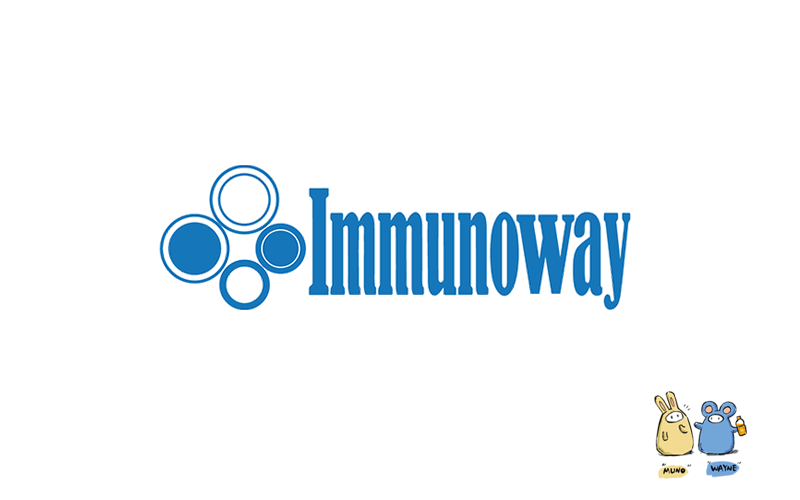
Catalog: YT7954
Size
Price
Status
Qty.
200μL
$450.00
In stock
0
100μL
$280.00
In stock
0
40μL
$150.00
In stock
0
Add to cart


Collected


Collect
Main Information
Target
PAX6
Host Species
Rabbit
Reactivity
Human, Rat, Mouse,
Applications
WB, ELISA
MW
46kD (Calculated)
Conjugate/Modification
Unmodified
Detailed Information
Recommended Dilution Ratio
WB 1:1000-2000; ELISA 1:5000-20000
Formulation
Liquid in PBS containing 50% glycerol, 0.5% BSA and 0.02% sodium azide.
Specificity
This antibody detects endogenous levels of Human PAX6
Purification
The antibody was affinity-purified from rabbit antiserum by affinity-chromatography using epitope-specific immunogen.
Storage
-15°C to -25°C/1 year(Do not lower than -25°C)
Concentration
1 mg/ml
MW(Calculated)
46kD
Modification
Unmodified
Clonality
Polyclonal
Isotype
IgG
Related Products
Antigen&Target Information
Immunogen:
Synthesized peptide derived from human PAX6
show all
Specificity:
This antibody detects endogenous levels of Human PAX6
show all
Gene Name:
PAX6 AN2
show all
Protein Name:
PAX6
show all
Other Name:
Paired box protein Pax-6 ;
Aniridia type II protein ;
Oculorhombin ;
Aniridia type II protein ;
Oculorhombin ;
show all
Database Link:
Background:
This gene encodes a homeobox and paired domain-containing protein that binds DNA and functions as a regulator of transcription. Activity of this protein is key in the development of neural tissues, particularly the eye. This gene is regulated by multiple enhancers located up to hundreds of kilobases distant from this locus. Mutations in this gene or in the enhancer regions can cause ocular disorders such as aniridia and Peter's anomaly. Use of alternate promoters and alternative splicing result in multiple transcript variants encoding different isoforms. [provided by RefSeq, Jul 2015],
show all
Function:
developmental stage:Expressed in the developing eye and brain.,Disease:Defects in PAX6 are a cause of autosomal dominant keratitis [MIM:148190]. It is an eye disorder characterized by corneal opacification and vascularization, and by foveal hypoplasia.,Disease:Defects in PAX6 are a cause of bilateral optic nerve hypoplasia [MIM:165550]; also known as bilateral optic nerve aplasia. Inheritance is autosomal dominant.,Disease:Defects in PAX6 are a cause of coloboma of optic nerve [MIM:120430].,Disease:Defects in PAX6 are a cause of ectopia pupillae [MIM:129750]. It is a congenital eye malformation in which the pupils are displaced from their normal central position.,Disease:Defects in PAX6 are a cause of foveal hypoplasia [MIM:136520]. Foveal hypoplasia can be isolated or associated with presenile cataract. Inheritance is autosomal dominant.,Disease:Defects in PAX6 are a cause of Gillespie syndrome [MIM:206700]; also called aniridia cerebellar ataxia and mental deficiency. Gillespie syndrome is a rare condition consisting of partial rudimentary iris, cerebellar impairment of the ability to perform smoothly coordinated voluntary movements, and mental retardation. It is not yet clear whether the disorder has an autosomal recessive or dominant inheritance.,Disease:Defects in PAX6 are a cause of ocular coloboma [MIM:120200]; also known as uveoretinal coloboma or coloboma of iris, choroid and retina. Ocular colobomas are a set of malformations resulting from abnormal morphogenesis of the optic cup and stalk, and the fusion of the fetal fissure (optic fissure). Severe colobomatous malformations may cause as much as 10% of the childhood blindness. The clinical presentation of ocular coloboma is variable. Some individuals may present with minimal defects in the anterior iris leaf without other ocular defects. More complex malformations create a combination of iris, uveoretinal and/or optic nerve defects without or with microphthalmia or even anophthalmia.,Disease:Defects in PAX6 are a cause of Peters anomaly [MIM:604229]. Peters anomaly consists of a central corneal leukoma, absence of the posterior corneal stroma and Descemet membrane, and a variable degree of iris and lenticular attachments to the central aspect of the posterior cornea.,Disease:Defects in PAX6 are the cause of aniridia type II (AN2) [MIM:106210]. AN2 is a bilateral panocular disorder characterized by complete or partial absence of the iris, absence of the fovea and malformations of the lens and anterior chamber. Severe age-related corneal degeneration is a frequent complication which contributes to a poor visual prognostis in aniridia. About one third of the cases are sporadic, and two thirds are familial, with autosomal dominant inheritance and high penetrance. Nearly one third of sporadic AN patients develop Wilms tumor in association with genitourinary anomalies and mental retardation (WAGR syndrome) as a consequence of heterozygous (sub)microscopic deletions of chromosome 11p13.,Function:Transcription factor with important functions in the development of the eye, nose, central nervous system and pancreas. Required for the differentiation of pancreatic islet alpha cells (By similarity). Competes with PAX4 in binding to a common element in the glucagon, insulin and somatostatin promoters. Regulates specification of the ventral neuron subtypes by establishing the correct progenitor domains (By similarity). Isoform 5a appears to function as a molecular switch that specifies target genes.,similarity:Belongs to the paired homeobox family.,similarity:Contains 1 homeobox DNA-binding domain.,similarity:Contains 1 paired domain.,subunit:Interacts with MAF and MAFB.,tissue specificity:Fetal eye, brain, spinal cord and olfactory epithelium. Isoform 5a is less abundant than the PAX6 shorter form.,
show all
Cellular Localization:
Nucleus .; [Isoform 1]: Nucleus .; [Isoform 5a]: Nucleus .
show all
Tissue Expression:
[Isoform 1]: Expressed in lymphoblasts. ; [Isoform 5a]: Weakly expressed in lymphoblasts.
show all
Research Areas:
>>Signaling pathways regulating pluripotency of stem cells ;
>>Maturity onset diabetes of the young
>>Maturity onset diabetes of the young
show all
Signaling Pathway
Reference Citation({{totalcount}})
Catalog: YT7954
Size
Price
Status
Qty.
200μL
$450.00
In stock
0
100μL
$280.00
In stock
0
40μL
$150.00
In stock
0
Add to cart


Collected


Collect
Recently Viewed Products
Clear allPRODUCTS
CUSTOMIZED
ABOUT US
Toggle night Mode
{{pinfoXq.title || ''}}
Catalog: {{pinfoXq.catalog || ''}}
Filter:
All
{{item.name}}
{{pinfo.title}}
-{{pinfo.catalog}}
Main Information
Target
{{pinfo.target}}
Reactivity
{{pinfo.react}}
Applications
{{pinfo.applicat}}
Conjugate/Modification
{{pinfo.coupling}}/{{pinfo.modific}}
MW (kDa)
{{pinfo.mwcalc}}
Host Species
{{pinfo.hostspec}}
Isotype
{{pinfo.isotype}}
Product {{index}}/{{pcount}}
Prev
Next
{{pvTitle}}
Scroll wheel zooms the picture
{{pvDescr}}




















